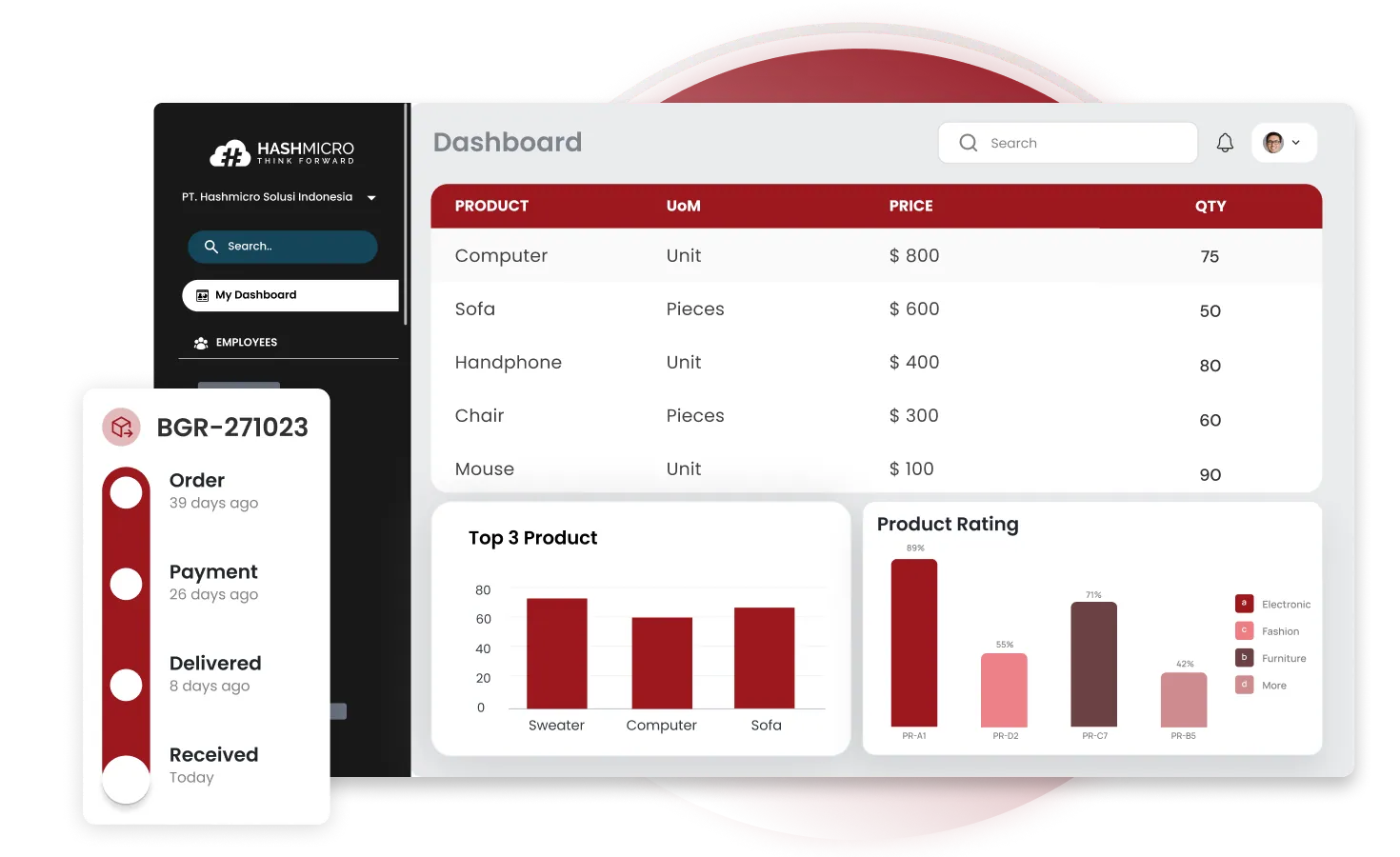Procurement is a complex field, and very high-stake in business. Did you know businesses spend 50-70% of their income on procurement? Which means, if you still do everything manually, either on paper or using different spreadsheets, you’ll experience expensive mistakes at some point in your business.
So, what’s the solution? You can try HashMicro’s Procurement System to assist your operations to minimize the errors! Plus, 94% of companies in the Philippines are now considering cloud-based IT solutions, which proves that a procurement system is necessary to cut down costs.
Read on for a comprehensive insight into how HashMicro’s best procurement system can help your company successfully operate in today’s market.
Key Takeaways
|
Table of Content
Content Lists
What is a Procurement System?
A procurement management system is software that helps businesses manage the process of buying goods and services. It automates tasks like creating purchase orders, tracking deliveries, and managing supplier relationships, which saves time, reduces errors, and helps control costs.
According to a report by the Chartered Institute of Procurement & Supply (CIPS), 60% of businesses experience procurement inefficiencies due to manual processes. These inefficiencies can lead to increased costs and delayed operations.
Without a proper procurement management system, companies often face several challenges, including manual errors, lost documents, and inefficient approval workflows. Procurement includes direct, indirect, and services procurement, each supporting different areas of business needs. Implementing an automated hardware procurement system can significantly improve these issues.
By automating and optimizing their purchasing processes using a system, businesses can achieve up to a 30% reduction in procurement costs. Additionally, the system provides real-time data and analytics, allowing companies to make informed decisions and negotiate better with suppliers.
Read also: Purchase Order vs Invoice, What’s the Difference?
How do indirect, direct, and services procurement differ from each other?
| Direct Procurement | Indirect Procurement | Services Procurement | |
| Definition | Acquiring goods/services directly related to production | Buying non-production-related goods and services required for daily operations |
Engaging with external experts who provide specialized skills through consulting firms or freelancers |
| Examples | Raw materials, components | Office supplies, utilities | Consulting, legal services |
| Focus | Production and manufacturing | Operational efficiency | Specialized expertise |
| Transaction Size | Higher individual values | Lower individual values | Variable costs |
| Supplier Relationship | Long-term partnerships | Diverse suppliers | Project-based or ongoing |
| Impact on Revenue | Directly impacts product availability and quality | Less direct impact on revenue | Can enhance operational efficiency |
| Market Dynamics | Influenced by commodity prices | More stable pricing | Subject to service market trends |
What does the Procurement Process entail?
1. Process
Process involves systematic planning, purchasing, and payment, ensuring compliance with policies and enhancing efficiency.
2. People
People are the teams responsible for procurement activities; clearly defined roles and ongoing training are essential for success, along with effective collaboration with stakeholders.
3. Paper
Paper refers to the necessary documentation that supports procurement activities. Comprehensive records promote transparency and accountability, ensuring compliance and providing a clear audit trail for transactions.
Functions of procurement management that need to be digitized
While procurement involves various functions, here are 5 key tasks that should be automated to reduce time, manual effort, and cost.
1. Purchase requisition
A purchase requisition system provides users a clear and straightforward way to request. It helps by offering options like preferred or frequently purchased items and recommending the best vendor, all while incorporating purchasing policies into the process to guide users appropriately.
With real-time policy enforcement, any errors or incomplete details in purchase requests are flagged immediately, ensuring accuracy and eliminating mistakes. Procurement management software with features like electronic data capture, routing, and approval processes ensures a smooth and consistent requisition experience for organizations every time.
2. Purchase order
A procurement management system eliminates the need for manual, paper-based purchase orders and repetitive data entry. It automatically converts purchase requisitions into as many purchase orders as needed based on the number of line items.
With purchase order software, stakeholders gain full visibility into the process and can easily track the status of a PO within the approval workflow at any time. The system ensures that purchase orders include all the essential details stakeholders need to make informed decisions and process them quickly.
3. Invoice approval
Invoice approval and processing is a key procurement task that can be significantly improved with automation. When a vendor submits an invoice, the procurement management system digitizes the paper invoice and cross-checks it against details like the supplier’s name and contract terms.
If there are any discrepancies, the system blocks payment and takes action based on predefined rules. If the invoice is accurate, it is automatically sent to the appropriate person for approval and final payment.
4. Vendor management
The vendor management and selection process is often manual, repetitive, and time-consuming. Procurement management software can streamline this process by automating tasks like background checks and following up on missing information or documents.
An automated vendor management system improves collaboration with suppliers by handling onboarding steps more accurately and efficiently. It also speeds up due diligence by processing, reviewing, and scoring vendors faster than manual methods.
5. Contract approval
Manual contract approvals can be extremely time-consuming. Contract management typically involves gathering and organizing contracts across the organization and securely storing them.
A procurement system streamlines this process by reviewing contracts, comparing them with pre-set templates, and identifying any deviations in terms and conditions. Automated contract management systems also track contracts over time to detect issues like non-compliance, approaching expirations, or other potential problems that could result in disputes if overlooked
Benefits of Procurement Software
As a tool to manage suppliers, procurement software significantly reduces the risk of cost overruns. By managing expenses through dedicated budgets and cost centers, businesses can ensure spending stays within limits.
Some of the benefits are:
- On-time payments: Automated reminders help businesses track invoices, improving supplier relationships and ensuring smooth cash flow management.
- Supplier risk management: The system enables continuous supplier evaluations, helping prevent late deliveries and quality issues while fostering stronger partnerships.
- Efficient backorder management: Flexibility in adjusting delivery and payment terms ensures smooth inventory control and optimizes cash flow.
- Improved S2P and S2C processes: Procurement software streamlines contract management, purchase orders, and quotations, reducing manual errors and enhancing procurement efficiency.
These are just four benefits of procurement management. By implementing such systems, businesses can gain greater control over their supply chain, reduce costs, and improve overall performance.
Ways to Improve Efficiency in Procurement Management
While organizations can benefit significantly by understanding the purpose of their procurement management processes and streamlining them, many organizations delay taking action because they don’t know where to start. The following are the key areas that procurement teams can digitize to improve the efficiency of their procurement processes:
- Leverage the latest automation technologies: A purchasing system helps automate procurement activities, improving efficiency and enabling paperless approvals for faster processing. It also allows real-time communication with vendors, helping to resolve issues quickly and prevent delays.
- Improved vendor management: Imagine handling all supplier-related issues in one centralized platform, from screening and onboarding new vendors to monitoring performance and addressing payment or delivery concerns. An e-procurement solution allows users to manage all vendor interactions efficiently on a single digital platform.
- Better control over business expenses: An online procurement management system simplifies budgeting, eliminating the need for complex spreadsheets and manual data transfers. It allows users to set and monitor budget limits, access detailed reports, and keep product catalogs updated, improving accuracy and reducing employee workload.
- Improved compliance: Procurement software consolidates key data into an easy-to-use dashboard, ensuring compliance with deadlines, quality standards, and regulations. It also helps prevent fraud and off-contract purchases, improving accuracy and reducing financial risks.
- Essential reporting features: Procurement management software allows users to access valuable data to evaluate and compare vendor performance. It also helps identify risks in purchasing processes and highlights areas for improvement.
How Procurement System Work

In short, a procurement system works by automating the steps needed to buy goods and services, like creating purchase orders and tracking deliveries. It helps businesses by organizing supplier information and purchase details in one place, making the process more efficient.
Here is a more detailed explanation of how the procurement management system works:
- Budgeting and planning: After identifying needs, the next steps include budgeting for procurement, forecasting demand, and strategizing the procurement approach.
- Vendor selection: Companies assess suppliers based on cost, quality, reputation, and performance, often issuing RFPs or RFQs to gather bids.
- Negotiation and contracting: Negotiations finalize terms, pricing, and schedules with selected suppliers. If agreed, contracts are signed to formalize the deal.
- Purchase order processing: Once contracts are established, POs are issued to formally request specified quantities and delivery terms of goods or services from suppliers.
- Performance monitoring: This procurement application monitors supplier performance, which is crucial for maintaining contract compliance, quality, timely delivery, and customer satisfaction in one system. To achieve this, utilize feedback and performance metrics.
- Supplier management: Maintaining positive supplier relationships is crucial for long-term success, fostered by effective communication, collaboration, and problem-solving.
Features to Look For in a Procurement System

An ideal procurement software should have a wide range of features and functions to meet the diverse needs of businesses. Here are some important features that businesses usually need:
- PR management: This feature lets users create and manage purchase requests, streamlining items or service requests for various departments through the system.
- PR to RFQ: It converts purchase requests into RFQs, allowing companies to request quickly, compare quotes from suppliers, and make informed decisions. A procurement system should have several types of RFQ template available, and better yet, a customizable one.
- PO management: This functionality allows users to efficiently create, track, and manage purchase orders while maintaining control over procurement activities from request to fulfillment.
- Work order receiving: This feature streamlines receiving work orders or goods from suppliers, ensuring correct items and quantities while maintaining accurate records.
- Supplier invoices: The system enables seamless management of supplier invoices, allowing organizations to process, track, and ensure timely payment and accurate financial records.
- Blanket order management: This blanket order management automatically creates long-term, repetitive purchase orders for regularly needed goods or services.
- Vendor price list submission & management: This feature lets vendors submit, manage, and update price lists electronically, ensuring users always have the latest pricing data for informed decisions.
- PR approval management: This feature enables companies to create a structured purchase requisition workflow, preventing unauthorized purchases, improving budget control, and increasing procurement accountability.
- Automate stock reordering: The integrated system automatically generates new purchase orders when stock is low, preventing shortages or overstocking.
- Online portal for suppliers: This feature lets suppliers interact with the procurement software online, making negotiations, deliveries, and order monitoring easier and quicker.
- Landed cost calculation: This feature calculates the total cost of purchasing goods, including shipping, insurance, and customs duties, for an accurate final cost overview.
When investing in a procurement management system, companies should consider not only the features but also the pricing. HashMicro, one of the best procurement management providers, offers a detailed pricing scheme file for prospective clients like you.
This file helps businesses estimate the budget needed to implement the system, ensuring a well-informed decision. You can access the file by clicking the banner down below.

Signs that Your Business Needs Procurement System

As the business grew and expanded, it became increasingly clear that you needed a robust procurement software solution to manage our procurement processes effectively. Understanding the procurement software’s meaning is essential in this context. Several challenges have emerged in our procurement operations, highlighting the urgent need for a comprehensive solution.
The following are signs that your company needs a comprehensive procurement management system:
- You have strong cost-reduction goals: To meet cost-reduction goals, a procurement system is essential. In addition to streamlining processes, it also eliminates inefficiencies, and enhances purchasing power, helping you achieve your objectives efficiently.
- Expenses are rising: Rising expenses challenge growing businesses, making cost management crucial. A procurement system identifies cost-saving opportunities, negotiates better supplier terms, and optimizes spending to reduce costs effectively.
- The procurement team can deliver ROI: A well-optimized procurement team can deliver significant ROI. By securing favorable contracts and refining processes, they maximize savings and ensure compliance with minimal effort.
- Your company is in growth mode: As your business grows, procurement complexities increase. A procurement system simplifies these processes, manages resources effectively, and supports scalable growth to keep pace with expansion.
- Increasing employees and locations: Expanding your workforce and locations raises the demand for goods and services. A procurement system centralizes control, ensuring consistency across all locations and departments, leading to better efficiency.
- Inaccurate data: Inaccurate data causes procurement issues and hinders strategic decision-making. A procurement system ensures data accuracy with centralized management, automated validation checks, and integration with other business systems.
- Time-consuming approval process: Manual approval processes slow procurement, causing bottlenecks. Automating approvals in a procurement system speeds up processes, enhancing overall efficiency.
- Conducting business without formal contracts: Operating without formal contracts exposes businesses to risks. A procurement system centralizes contract storage, tracks renewals, and ensures compliance, reducing legal and financial vulnerabilities.
Also read: 5 Free Purchase Order Template in Excel and Word
HashMicro Procurement System as a Comprehensive Solution for Your Business

HashMicro’s Procurement System is the best procurement management solution for businesses in the Philippines. The system helps companies streamline purchasing processes, reduces errors, and provides real-time data, ensuring efficient and cost-effective procurement operations.
Other than the features mentioned in the previous section, HashMicro’s procurement system also provides several more advanced features, such as:
- E-procurement: This feature allows businesses to conduct tenders and request quotations online, simplifying and speeding up the procurement process.
- OCR for RFQ: OCR technology quickly scans and processes RFQ documents, reducing manual entry errors and saving time.
- Automatic vendor rating: This feature automatically evaluates vendors based on punctuality, pricing, and completeness, helping businesses choose the best suppliers.
- Periodic vendor rating review: Regular reviews of vendor ratings ensure continuous improvement and maintain high standards in supplier performance.
- KPI target per purchaser: Setting KPI targets for each purchaser helps track performance and ensures procurement goals are met efficiently.
- Cost savings tracking and reporting: This feature monitors and reports cost savings, enabling businesses to measure the financial benefits of their procurement activities.
- Vendor promotion program management: Managing vendor promotions through the system helps strengthen supplier relationships and can lead to better deals.
- Custom printout in RFQ: Customizable RFQ printouts allow for tailored requests based on different purchase types, improving clarity and specificity.
- Budget tracking & limit per purchase: This procurement application tracks budgets and sets purchase limits within the system, helping businesses control spending and avoid overspending.
By utilizing HashMicro’s advanced procurement tools, including e-procurement, businesses can simplify tender processes and manage vendor relationships more effectively. Moreover, features like periodic vendor rating reviews, and KPI tracking ensure a smoother, more controlled procurement process.
Conclusion
Procurement Management Systems are designed to drive business efficiency by ensuring that every procurement process facilitates well-informed decisions. Furthermore, good procurement software must include a comprehensive set of features, such as a purchasing system, supplier or vendor management, and financial reporting.
In the Philippines, HashMicro stands out as one of the best Procurement Software providers. Not only does it offer fully customizable features tailored to your business needs, but it also enables your company to streamline procurement processes, gain actionable insights, and confidently drive growth.
Explore how HashMicro’s software solutions can transform your procurement management processes, and try a free demo today!

Frequently Asked Questions About Procurement System
-
What is the purpose of the procurement system?
A procurement system streamlines the purchasing process, reduces errors, and manages supplier relationships. Additionally, this help control costs, improve efficiency, and ensure compliance with company policies.
-
What is an example of a procurement system?
An example of a procurement system is HashMicro’s Procurement Software, which automates supplier management, purchase orders, and vendor ratings, enhancing procurement efficiency.
-
What are the main functions of procurement management?
Procurement management involves sourcing suppliers, negotiating contracts, managing purchase orders, and ensuring timely delivery of goods and services, all while optimizing costs.
-
What is the procurement management system?
A procurement management system is a software solution that helps businesses manage the entire procurement process, from sourcing suppliers to purchasing goods and services. It automates tasks, tracks orders, ensures compliance, and improves efficiency in procurement activities.
-
What is an example of a procurement system?
An example of a procurement system is HashMicro, a cloud-based solution that helps businesses automate procurement tasks, manage supplier relationships, track purchases, and ensure compliance with company policies. It simplifies the entire procurement process from request to payment.




































